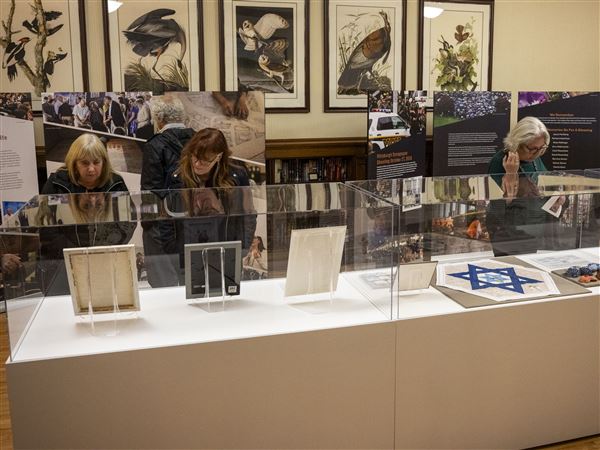Romare Bearden's mural "Pittsburgh Recollections," reinstalled in the Gateway Center light-rail station Downtown, has pride of place, its colorful and vibrant ceramic tiles bathed in natural light in an airy, glass-canopied space.
Created for the original subway in 1984, the work was painstakingly removed in 2009 during construction of the new station and the North Shore rail extension. Gateway Center Station begins service March 25, but you don't have to take a ride to see the mural, which expands its potential as a cultural tourism destination.
The 60-by-13-foot work depicts Pittsburgh's history through bright, abstract forms, from Native Americans and early settlers through mill laborers to a future based in technology, science and education, all set against a flowing background of undulating hills and rivers.
Commissioning public art is often difficult because it serves a broad audience and because it is, by nature, contemporary, which often equates with edgy. That's why a traditional approach has appeal, whether the larger-than-life statue of Martin Luther King Jr. on the Mall in Washington, D.C., or that of Penguins hero Mario Lemieux, recently unveiled at Consol Energy Center. Both are realistic depictions of people and the intent can't be misconstrued. Some public art doesn't hold up well in the long run and is eventually looked upon as an oddity of its period or even snatched away to storage purgatory.
The best outcome is when the choice is visionary and the work becomes integral to, even emblematic of, a place. Such was the commissioning by the Port Authority of Allegheny County of Mr. Bearden's mural.
Among the most important 20th-century African-American artists, Mr. Bearden was born in 1911 in Mecklenburg County, N.C., and died in 1988 in New York City. He had moved as a child with his family to Harlem when the Harlem Renaissance was in full swing and Mr. Bearden grew up in the company of the black cultural, political and intellectual elite. His maternal grandparents, Carrie and George Banks, owned a boardinghouse in Pittsburgh that he visited frequently, and he is a graduate of Peabody High School.
It was at the boardinghouse that Mr. Bearden became aware of artmaking on a personal level. As a child, he became friends with a boy named Eugene who was infirm and spent time drawing on paper bags and newsprint, said Cecile Shellman, artistic director, visual arts and exhibitions, for the August Wilson Center for African American Culture. The boy died soon after, but "Bearden credits that memory with his interest in art."
Ms. Shellman was invited by Renee Piechocki, director of the Office of Public Art, to write about the artist for signage in the subway to inform passengers about the mural.
She said the mural is "more accessible than other public art pieces, instead of just being a work of art, a little esoteric, more focused on a single idea or single person.
"This shows the love Bearden has for Pittsburgh -- the city of Pittsburgh, the place, pattern, workers with their lunchboxes, the everyday man." She thinks it "fitting that it's located in the subway because trains were a motif throughout his life."
Mr. Bearden had come into his own by the time of this commission, said Mary Schmidt Campbell, a Bearden scholar and dean of the Tisch School of the Arts at New York University.
"He was a pretty well-established collage artist," who had earlier been given a retrospective by the Museum of Modern Art in New York City.
The Pittsburgh mural is among 15 major public art pieces that he made in a variety of materials in venues from New York's Times Square to Berkeley, Calif.
"What's interesting is that he was adventurous, translating the medium of collage into several media," including stained glass, ceramic and fiber.
He "really tried to take the pulse of each venue," Ms. Campbell said, as expressed in the cultural and industrial panoramas for the Pittsburgh mural. "He gives a flavor of the city where the mural resides. He did research."
Ms. Campbell admires Mr. Bearden's inclusion in his work of "narrative and history and all of those things not within the realm of modern art. He was something of an iconoclast, challenging some of the tenets of modernism. What I always love about him is he shows how our histories are all entwined with one another."
The "Pittsburgh Recollections" commission, part of the LRT Arts Project established in 1981, was $90,000. The mural was recently appraised at $15 million.
In addition to Ms. Shellman's biographical material, the signs tell about the complicated and challenging project to move, conserve and reinstall the mural at a total cost of $1.2 million.
The mural comprises 780 ceramic tiles, each 12 by 12 inches and 1/4-inch thick. They were adhered to a 3-foot-thick concrete wall reinforced with rebar. McKay Lodge Conservation Laboratory of Oberlin, Ohio, was contracted for the deinstallation and employed a chain saw with a diamond bladed chain saw to cut into the concrete behind each tile at a 11/2-inch depth. An ultra-thin cutting blade (6/100-inch thick) was used to cut between each tile.
Back in Ohio, a specially designed CNC (computer numerical control) machine with a diamond blade saw cut grooves through the remaining concrete to the backs of the numbered tiles. The remaining concrete could then be chipped away by hand. The residual cleaning, including desalination, was accomplished at the rate of five to seven tiles a day.
The problems the conservators found -- cracks, stains, mineral deposits from seeping water -- were "pretty routine matters to deal with," said Robert Lodge. Conservators found areas of red glaze that had been lost or damaged. Some had been retouched with red paint, which had failed, and the conservators touched up those areas. (Mr. Bearden himself painted the stoneware tiles, which were fired by Bennington Potters in Vermont.)
The tiles were mounted on panels, so that they may be more easily moved should the need ever arise, by Intermuseum Conservation Association of Cleveland, which was also contracted to reinstall them.
One tile that had mistakenly been placed upside down during the mural's original installation was replaced that way, honoring tradition. Unfortunately, the overall surface alignment of the tiles is not as smooth as it should be.
Jerry Marinzel, project manager, North Shore Connector, said he did point that out to ICA. He noted that the tiles "weren't laser-straight" on the original wall. Also, their new panel mounting makes it more difficult to close gaps.
That shouldn't dim the achievement of having saved this important work of art, and its sparkling reappearance in the midst of centennial year celebrations of Mr. Bearden's birth.
First Published: March 14, 2012, 8:00 a.m.
















